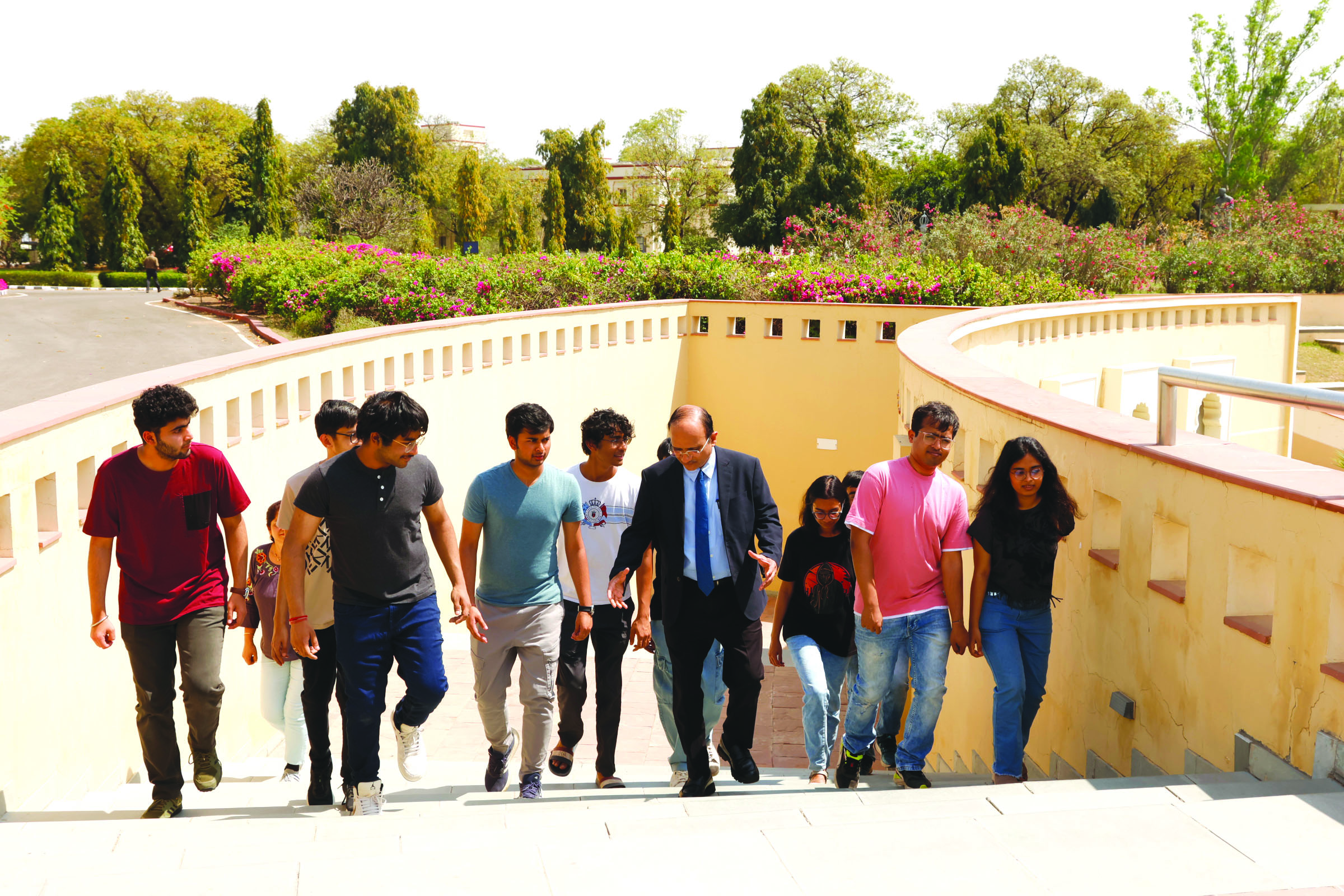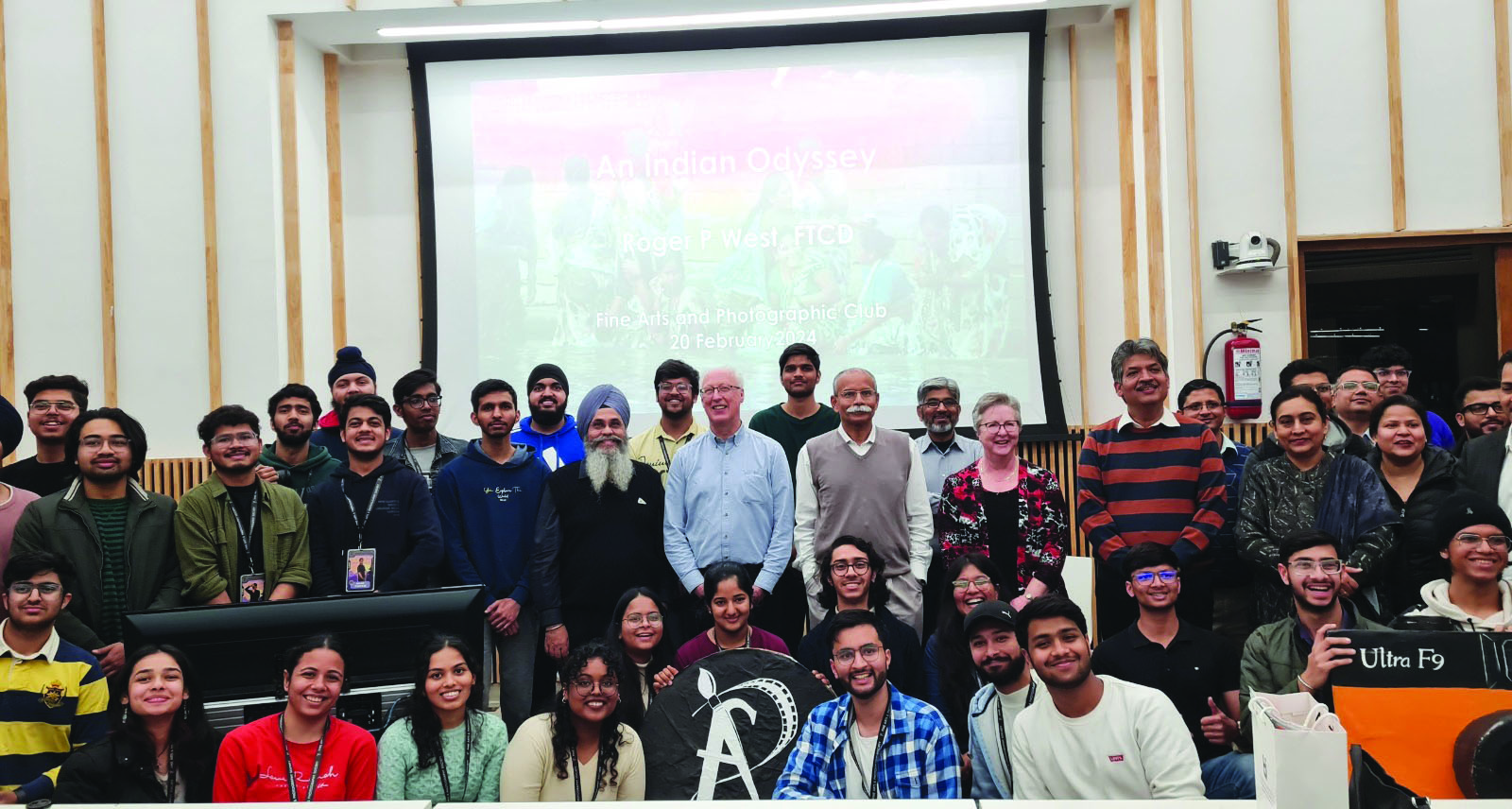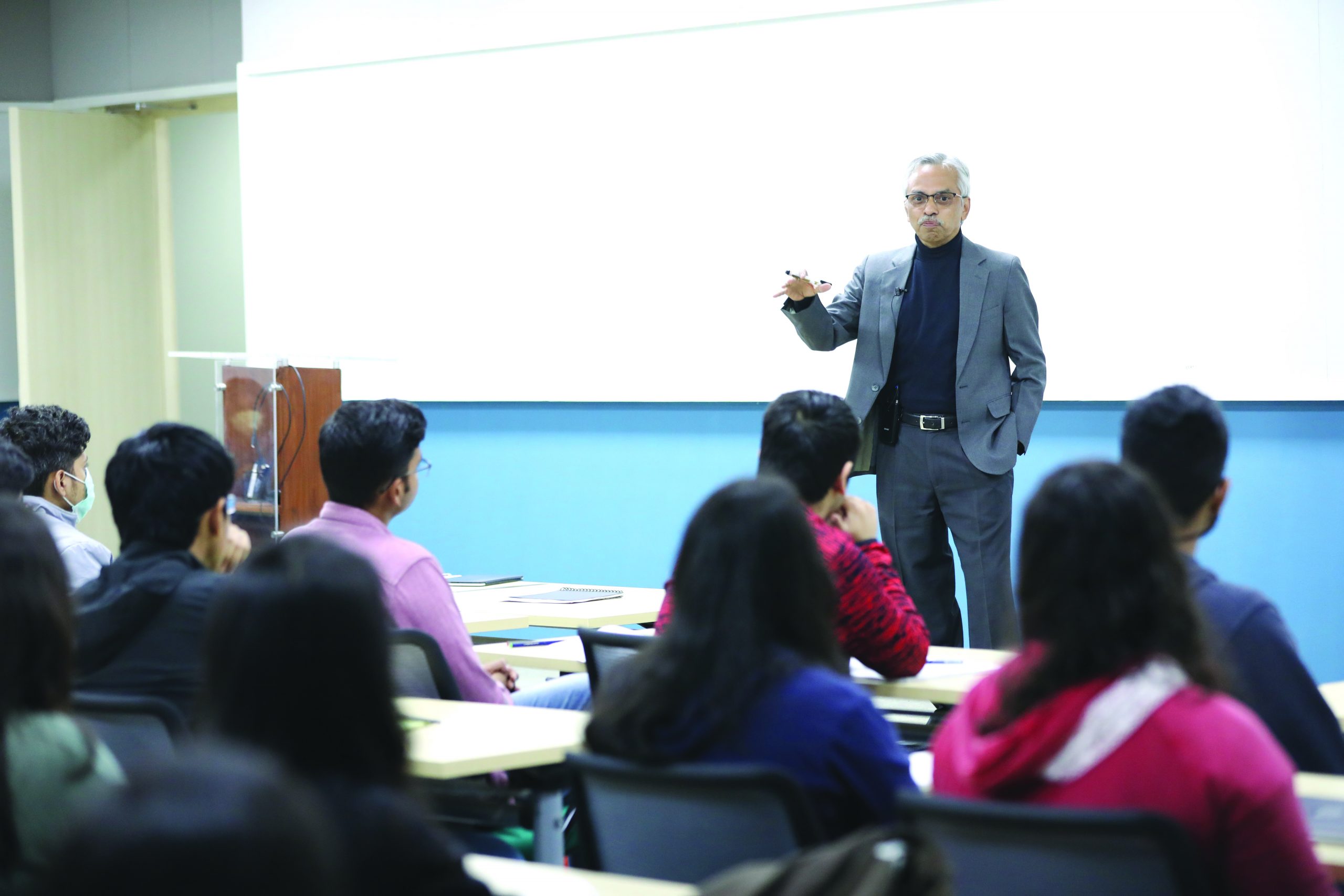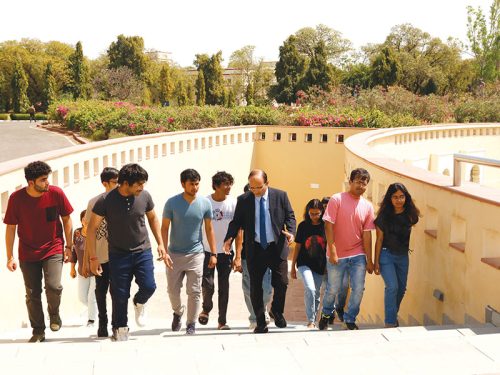No products in the cart.
India’s Premier Private Engineering & Technology Universities 2024-25
Attaining the $30 trillion GDP dream by 2047 necessitates private engineering and technology universities skilling an army of managers and workers in STEM subjects

Prof. Ramgopal Rao (centre): research powerhouse & start-ups incubator
If the lofty Viksit Bharat (‘developed India’) with a $30 trillion GDP dream of Prime Minister Narendra Modi — who seems set to serve a third consecutive term in office after results of General Election 2024 are announced on June 4 — is to be realised, India’s manufacturing sector which currently contributes a mere 17 percent of GDP, has to at the very least double its contribution.
Although most economists and pundits believe this requires heavy investment in infrastructure, plant and machinery, it also necessitates skilling an army of managers and workers in STEM (science, technology, engineering and mathematics) subjects. In turn, this requires upgrading and developing excellent engineering colleges and universities equipped with best faculty, latest technologies and laboratories and well-furbished libraries.
During the past 75 years after India wrested independence from foreign rule, the country’s omniscient central planners provided for substantial investment in steel, coal, fertiliser, cement, pharmaceutical and other core industries, but did not develop sufficient human resources to efficiently manage giant corporations which were promoted by government under socialist ideology. Consequently public sector enterprises (PSEs), which were budgeted to transform independent India into a manufacturing powerhouse, were dominated by bureaucrats and clerks who quickly drove them into bankruptcy and/or heavy dependence upon annual allocations from the Central and state government budgets.
Admittedly, India’s first prime minister Jawaharlal Nehru who was enamoured with Soviet socialism and government controlled centrally planned economy, promoted India’s famous IITs (Indian Institutes of Technology) in Kharagpur, Bombay and Delhi which have since multiplied into 23 institutions. But because of the slow growth of the economy (3.5 percent per year) for over four decades, 50 percent of IIT graduates trained at great public expense, migrated overseas every year and those who remained were stuck in technical jobs without the freedom to expand PSEs into large-scale globally competitive corporations. Moreover given the small number of IITs, even to this day they admit a mere 2 percent of the 1.2 million engineering aspirants who write the annual IIT-JEE (joint entrance examination ) and produce a mere 10,000 graduates per year.
With the vast majority of engineering and technology aspirants obliged to sign up with private engineering colleges — 70 percent of all engineering and technology higher education institutions are privately promoted — and IITs routinely topping the league tables published by the media and government, a decade ago, your editors resolved to eliminate IITs from the annual EducationWorld India Higher Education Rankings and rank the country’s most admired Top 100 private engineering and technology universities. Since then, we have been ranking private undergrad colleges and private universities separately, even though some private engineering colleges awarded deemed university status are listed in both league tables.
In EWIHER 2024-25, the Birla Institute of Technology and Science (BITS)-Pilani has retained its #1 rank as the country’s pre-eminent private engineering university for the third year in succession. The 2,100 sample respondents interviewed for this exercise, awarded BITS-Pilani promoted by pioneer industry magnate the late G.D. Birla (1894-1983) in 1964, top scores under six of the ten parameters of engineering and technology excellence, viz, competence of faculty, faculty welfare & development, research & innovation, placement, infrastructure, and leadership/governance.
Prof. V. Ramgopal Rao, an alum of IIT-Bombay and Universitat der Bundeswehr, Munich (Germany) and former director of IIT-Delhi, who took charge last year as Vice Chancellor of BITS-Pilani which has established five campuses including Dabolim (Goa), Mohali (Punjab) and Dubai and has an aggregate 18,000 students mentored by 470 faculty, is not surprised by the top rank awarded to this institute by EW sample respondents year after year.
“Within academia and industry from where your sample respondents are drawn, BITS-Pilani’s record as a research powerhouse and incubator of start-ups is well-known. Over the past few years, 6,400 BITS-Pilani alumni have founded start-ups valued at $60 billion of which 15 are unicorns. Our research output cited in reputed refereed journals is among the Top 5 in India. And, the median remuneration awarded to our graduates is Rs.20-22 lakh. Within academia and industry, BITS-Pilani is commonly placed on a par with the best IITs,” says Ramgopal Rao, who attributes the institute’s modest NIRF ranking to its “low profile in government circles”.
According to Prof. Rao, the institute’s USP (unique selling proposition) is its strong connect with industry and its rigorous internships and “practice schools” programme in which students can work in industry for an entire semester before graduation. “One of the infirmities of Indian higher education is that it tends to be too theoretical. Our highly successful internship and longer duration practice schools programmes prepare students to become job-ready and hit the ground running when they graduate,” he told EducationWorld, which interviewed him last month when BITS-Pilani — which also admits higher secondary school-leavers into its undergrad programmes — was voted India’s premier engineering college.
In the EW 2024-25 private engineering & technology league table, BITS-Pilani is followed by the low-profile Thapar Institute of Engineering & Technology Deemed University, Patiala which has retained its #2 rank and is jointly ranked with the Vellore Institute of Technology University (#2 in 2023-24). The International Institute of Information Technology, Hyderabad #3 (3) is followed by the Dhirubhai Ambani Institute of Information & Communication Technology, Gandhinagar at #4 (3) and BML Munjal University, Gurgaon at #5 (6).

TIET’s Dr. Padmakumar Nair (centre right): India #2, Punjab #1
Dr. Padmakumar Nair, Director of the Thapar Institute of Engineering & Technology, Patiala (TIET, estb. 1986), is pleased that TIET has retained its #2 India and #1 Punjab ranking for the third year in succession. “TIET has always been ranked among the top engineering education institutions in all media surveys. We are also ranked India #22 in the Union education ministry’s latest NIRF rankings, outperforming several IITs and NITs,” says Nair, an alum of IIT Kharagpur and Heriot-Watt University, UK appointed Director of TIET in 2023.
Nair believes that over the past 58 years TIET has established a stellar reputation for its “excellent infrastructure, robust placement record, exceptional faculty, emphasis on research, and strategic partnerships with foreign universities”. “We are committed to providing our students a conducive learning environment, strengthening academy-industry connections, nurturing a research culture, promoting global perspectives, and shaping skilled professionals and innovative thinkers ready for success in the global arena,” adds Nair. Currently TIET hosts 10,465 students mentored by 723 full-time faculty.
Further down the Top 10 table of India’s most respected private engineering universities, the intensively advertised Lovely Professional University, Phagwara (Punjab) has been awarded a big promotion to #6 (9) and Hindustan Institute of Technology & Science, Chennai to #8 (10).
Beyond the Top 10 and until #20, there are minor changes from 2023-24 in this year’s league table of India’s most admired private engineering universities. Most institutions have retained their rankings, give or take a rank.

Plaksha U’s Dr. Rudra Pratap: “grand challenges of 21st century” excitement
The most notable is the debut of previously unranked new wave Plaksha University, Mohali (PU, estb.2021) at #20. The crowd-funded PU bills itself as India’s first technology university promoted after the first three IITs (Indian Institutes of Technology). This new state-of-the-art digital technologies driven fully-residential private university established at a project cost of Rs.850 crore on a 50-acre campus in Mohali (Punjab) has 370 undergrad, Masters and some Ph D students enrolled in four new-age interdisciplinary study programmes — computer science & artificial intelligence; cyber security systems; biosystems engineering and data sciences, economics and business.
“Although we are a very young university and none of our students have graduated, our bold curriculum designed to focus on grand challenges of the 21st century has generated considerable excitement in India and abroad. Recently, we concluded student and faculty exchange agreements with some of the most respected universities worldwide, including UC, Berkeley, UC San Diego, Purdue, Cornell and U Penn. These agreements will enable our students to greatly benefit by way of international mobility and joint programmes which will equip and prepare them for international workplaces,” says Dr. (Prof.) Rudra Pratap, an alum of IIT-Kharagpur and Cornell University (USA) and former faculty at the top-ranked Indian Institute of Science, Bangalore (1996-2021), appointed founding vice chancellor of this ambitious, high-potential technology university in early 2023.
The EW league table of private engineering universities constitutes an exclusive list of high quality engineering and technology HEIs because UGC — the apex-level supervisory body for higher education — is loath to confer autonomy on private education institutions and sets a high qualification bar for them. Therefore, all universities in the EW league table are ipso facto among India’s best — even if laggard by global standards — engineering institutions.
Moreover readers should bear in mind that institutions modestly ranked in the national league table may well be heavyweights in their host states. For instance, the Jaypee Institute of Information Technology, Noida ranked #11 nationally is the #1 private engineering university in Uttar Pradesh (pop.230 million); University of Engineering & Management (UEM), Kolkata India #23 is #1 in West Bengal (pop.102 million) and the Gandhi Institute of Engineering & Technology (GIET), Rayagada ranked India #25 is the #1 private university of Odisha (pop.47 million).
Although the EducationWorld India Higher Education Rankings 2024-25 has solicited informed opinion to evaluate India’s most reputed public and private engineering universities, it’s important to bear in mind that India’s best are laggards by international standards. Bringing them up to speed to compare and compete with the world’s best engineering and technology HEIs is a mission of utmost importance if 21st the country is to realise the dream of a Viksit Bharat and $30 trillion GDP economy. To this end, government, managements, faculty and students have a critically important responsibility to discharge.















Add comment